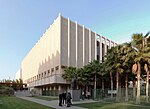La Brea Tar Pits
1901 in paleontology1964 in paleontology20th century in Los AngelesAsphalt lakesCalifornia Historical Landmarks ... and 17 more
Environment of Los AngelesFossil parks in the United StatesLa Brea Tar PitsLagerstättenLandmarks in Los AngelesMid-Wilshire, Los AngelesMuseums in Los AngelesNational Natural Landmarks in CaliforniaNatural history museums in CaliforniaNatural history of Los Angeles County, CaliforniaPaleontology in CaliforniaParks in Los AngelesPetroleum in CaliforniaPleistocene CaliforniaPleistocene paleontological sites of North AmericaUse mdy dates from November 2018Wilshire Boulevard

La Brea Tar Pits and Museum is an active paleontological research site in urban Los Angeles. Hancock Park was formed around a group of tar pits where natural asphalt (also called asphaltum, bitumen, pitch, or tar; brea in Spanish) has seeped up from the ground for tens of thousands of years. Over many centuries, the tar preserved the bones of trapped animals. The George C. Page Museum is dedicated to researching the tar pits and displaying specimens from the animals that died there. La Brea Tar Pits is a registered National Natural Landmark.
Excerpt from the Wikipedia article La Brea Tar Pits (License: CC BY-SA 3.0, Authors, Images).La Brea Tar Pits
Wilshire Boulevard, Los Angeles Mid-Wilshire
Geographical coordinates (GPS) Address Website External links Nearby Places Show on map
Geographical coordinates (GPS)
| Latitude | Longitude |
|---|---|
| N 34.0628 ° | E -118.356 ° |
Address
La Brea Tar Pits and Museum
Wilshire Boulevard
90036 Los Angeles, Mid-Wilshire
California, United States
Open on Google Maps








